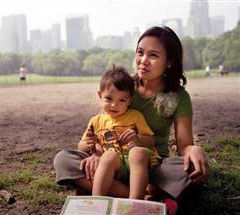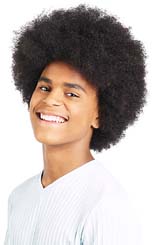|
Intermix.org.uk is a website for the benefit
of mixed-race families, individuals and anyone who feels they have a multiracial
identity and want to join us. Our mission is to offer a view of the mixed-race experience, highlighting icons, film, books, poetry, parenting techniques, celebrities, real lives and much more. Our online forums are a great place to meet others, ask questions, voice your opinions and keep in touch. Sign up for our monthly newsletter and delve into our pages. Want to join in? Become an Intermix member to take part: |
Emil's Big Chance Leaves Me Uneasy
 In
the 21st Century there seems to be more light brown faces in the media
than ever before. Should we be happy about it or are there more serious
implications?
In
the 21st Century there seems to be more light brown faces in the media
than ever before. Should we be happy about it or are there more serious
implications?
Tricia Capistrano wrote about her thoughts in Newsweek.
Brad Pitt and Angelina Jolie may have
the most popular baby in the world right now, but I do not envy them.
I had my taste of celebrity when I took my infant son on a trip to the
Philippines two years ago. I walked away from him for a moment at a baby-goods
store in Manila and when I returned, he was surrounded by four women
in their 20s who were ogling him. 'He is so cute!' they said. 'So fair-skinned!'
Whether we were in the mall or at church, people would gather around
to look at his face.
My son is mestizo, of mixed race. My husband is Caucasian with ancestors
from Sweden and Slovakia. I am a brown-skinned woman from the Philippines,
where many people I know have a fascination with the lighter skinned—probably
because our islands were invaded so many times by whites who tried to convince
us that they were better and more beautiful than us. We were under Spain's
rule for nearly 400 years, the United States' for almost 50. As a result,
skin-whitening products fly off the pharmacy shelves.
'Any plans to move back here?' my relatives
ask when I visit.
'I'll send Emil when he is a teenager so he can become a matinee idol
and fund our retirement,' I joke. Most of the country's famous actors
are of mixed-race, and the teen actors who are on their way up don't
have to be talented, just fair-skinned and preferably of Spanish, American
or Chinese descent.
I started to reconsider my response several months ago after my husband
and I read that by the time our son goes to college in 16 years, his
education will cost about $500,000. When we visited my parents last
January, I asked my friends in the advertising industry if I could bring
my son by their offices to take some test shots. I wondered if he could
land a commercial for diapers, cereal or maybe ice cream.
By the time I got the number of an agent, I had started to second-guess my idea.
I realized that I was going to be part of the system that can sometimes make
us dark-skinned people believe that we are inferior. I do not want Filipino children
who look like me to feel bad about themselves. When I was a kid, my grandmother
would get upset whenever I told her that I'd be spending the afternoon swimming
in my cousin's pool, because it meant that my skin would get darker than it already
was. My mom, whose nose I acquired, has one of the widest among her brothers
and sisters. She taught me to pinch the bridge daily so that the arch would be
higher, like my cousins. Most of her girlfriends got blond highlights and nose
jobs as soon as they received their first paychecks, almost as a rite of passage.
As a teenager, I tried to hang out with the mestizas, because I wanted to be
popular like them. It was only when I was 22 years old and moved to New York,
where people of different colours, beliefs and sexual orientations are embraced,
that I learned to appreciate my brown skin, wide nose, straight, black hair and
five-foot stature. Because of the self-confidence I saw in the people I met,
I found everyone—in the subway, on the street, in restaurants—beautiful.
When some of my friends in Manila express disappointment that their children
are not as light-skinned as Emil, I tell them it doesn't matter. And for a long
time, I've been content with my decision to scrap my plans for Emil to be on
the airwaves. I felt I was doing my share for my brown brothers and sisters.
Then, on one of the first warm days this spring, Emil and I went to the playground
with our half-Irish, half-Polish neighbour, Julia, and her son. While we were
watching the kids play, I joked that I was going to send Emil to the Philippines
to be on TV. 'Oh, that would be great!' she said earnestly. She told me that
as a little girl she had been in a series of Kodak commercials in the 1970s,
ads I remember seeing during episodes of Three's Company. Julia's parents
were working class, so it was the only way they could afford to pay for her college
education.
Once again, I'm tempted to call that agent. After
all, I am sure other fair-skinned children are being chosen to appear
in Philippine commercials even as I write this. I know my boycott is
just an anecdote in the world's bigger drama. The real stage is in my
decolonised mind. If my son ever lands a part on TV because of his colour,
do I want to be the one who has cast him?
Source:msnbc.msn.com
:
